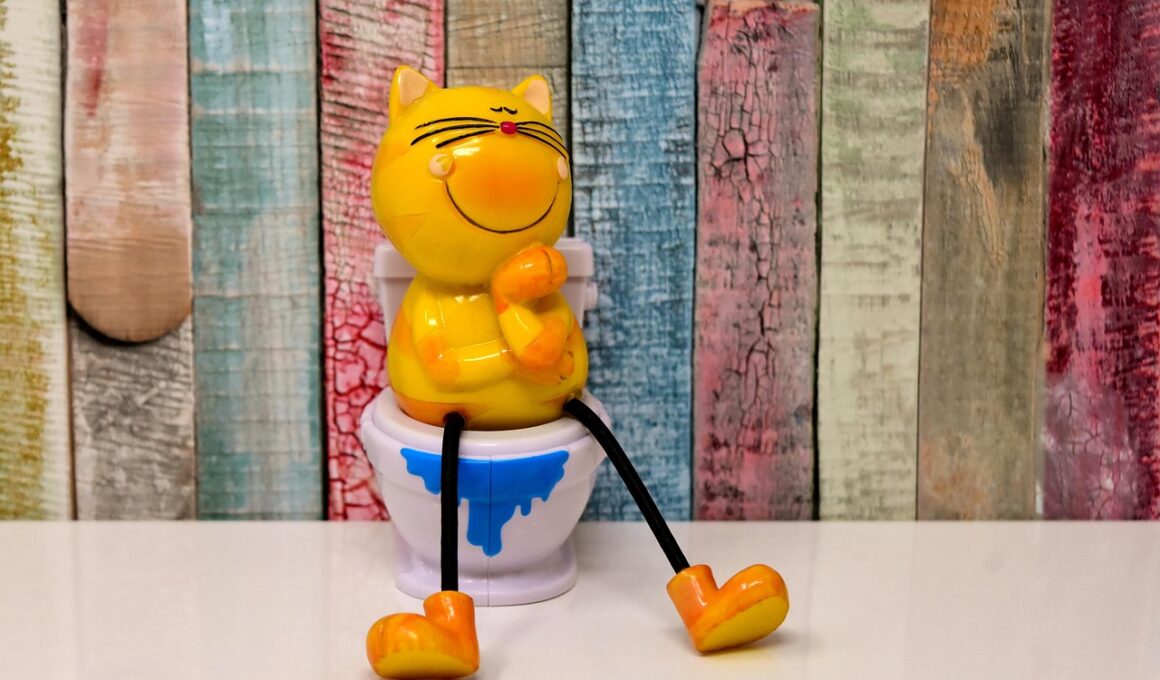Cleaning Techniques to Make Litter Boxes More Inviting
Ensuring your cat views the litter box as a safe and welcoming place starts with cleanliness. Regular cleaning is vital for encouraging your feline to use the box consistently. Start by emptying the litter box at least once a week and thoroughly scrubbing it with a mild, unscented soap. Avoid strong chemicals as they might deter your pet from entering. Rinse thoroughly to remove any soapy residue, and let it dry completely before adding fresh litter. Choose a litter material that your cat seems to prefer. It’s crucial to observe your cat’s preferences as their comfort greatly influences their willingness to use the box regularly. Ensure the litter box is located in a quiet area, away from high traffic spots, as cats appreciate privacy when using their facilities. Also, maintain a low litter depth, ideally about two to three inches; too deep may deter your cat. Regularly check for any blockages and keep sides clean. Consider having multiple boxes in separate locations if you have multiple cats. Lastly, keep the litter box covered to provide a sense of security while ensuring it doesn’t become too stuffy.
Using the right type of litter can make a significant difference in encouraging your cat’s litter box usage. Cats may avoid a box if the litter texture or scent is off-putting. Experiment with different types, including clumping, non-clumping, clay-based, or natural options to find their preference. Generally, unscented litters are more accepted by cats. Older, experienced cats may particularly dislike litter with overpowering fragrances. Also, some cats prefer finer-grain litters that mimic the soil texture, while others might appreciate coarser varieties. Additionally, changing litter too often can confuse your cat because they rely on familiar scents. Gradually transition to a new type by mixing some of the old litter with the new. Observe their reactions: if they show signs of aversion by avoiding the box, then revert back to the previous litter. Pay attention to their litter box habits as these behaviors can indicate issues such as health problems or dissatisfaction with their options. Keep your cat’s health in check—regular vet check-ups can clarify if any physical problems contribute to their litter avoidance.
Location, Location, Location
Where you place the litter box can significantly affect your cat’s willingness to use it. Cats are naturally cautious animals and prefer quiet, safe spaces to relieve themselves. Avoid high-traffic areas of your home, as the hustle and bustle could deter them from using the box. On the flip side, a box placed in a frequently used area may lead to stress and reluctance. An ideal location offers both privacy and access, perhaps a slightly secluded corner. Similarly, ensure your cat has easy access to the box; young, disabled, or elderly cats may have particular difficulties accessing high or awkward places. Moreover, avoid placing the box close to their food and water areas, as cats generally prefer to keep these zones separate. If litter boxes are positioned incorrectly, even the cleanest box may become unappealing. Two boxes in separate locations may work wonders if you have multiple pets, allowing each cat to feel secure. Finally, regularly review the preferred location as your cat’s behavior may change over time with age and comfort levels.
Remember that litter boxes aren’t just about cleanliness and location; they should also be properly sized to accommodate your cat comfortably. Ideally, the box should be long enough for your cat to stretch without feeling cramped or uncomfortable. Oversized boxes can sometimes feel intimidating, especially to smaller cats. Provide a box at least one and a half times the length of your cat to encourage exploration and use. If you’re unsure, you can test different box styles to see which they prefer. Open boxes offer more space and allow better ventilation, making them more inviting. Alternatively, some cats appreciate having a lid for privacy. Regardless of your choice, always ensure there is at least one box per cat, plus one extra, to minimize territorial disputes. Keeping the box clean and inviting is as important as making sure your feline recollects and recognizes where they should relieve themselves. Regular monitoring can also help you adapt to behavioral changes that might indicate that it’s time for box adjustments or an evaluation of their health.
Encouraging Happy Associations
Associations play a huge role in your cat’s behavior regarding their litter box. To create a positive relationship, consider rewarding your cat smoothly with treats or affection after they use the box correctly. This allows them to connect the action with a pleasant experience. Avoid negative reinforcement for mistakes, as it can create anxiety and may lead to further avoidance. Instead, gently direct them back towards the box without frustration. Sometimes a cat’s aversion to the box can be linked to a previous negative experience, such as a surprising noise or injury while using it. These associations can linger, making it essential to foster a safe and stress-free environment that encourages explorative behavior. Additionally, ensuring the box is indeed a comfortable place may involve experimenting with different liners or mats to improve traction and reduce slips. Moreover, incorporating comfortable elements around the box, like familiar toys or soothing scents, can promote a welcoming atmosphere. This gentle approach ensures your cat learns to view the litter box less as a chore and more as a natural and pleasant environment for their needs.
Some pet parents may find certain cleaning agents are more appealing to their cat’s senses than others, impacting their litter box usage. While soap and water are essential for the cleaning process, consider using natural cleaning products that are safe for felines. A mixture of vinegar and water can be effective without leaving harmful residues. Do avoid ammonia-based products, as their smell can be off-putting to cats. After cleaning, ensure the box is well-rinsed and entirely dry before filling it with fresh litter. Positive reinforcement is pivotal; you can experiment with different cleaning agents to find what your cat responds to. Regularly sanitizing the litter box can prevent complaints or foul odors while ensuring your cat is delighted with their box. Encourage your feline to use it by ensuring it remains inviting and clean so that they don’t opt for alternative spots. Additionally, monitor the aesthetic appeal of the box. If it’s unsightly or bulky, it may be worth investing in a more visually appealing alternative that fits your home decor while remaining functional.
Health Considerations in Litter Box Avoidance
Finally, it’s essential to consider that frequent avoidance could signify underlying health issues manifesting in your cat’s behavior. A change in litter box habits can indicate stress, anxiety, or even medical concerns such as urinary infections or digestive problems. Pay close attention to your cat’s health and habits. If you notice any surprising changes, including blood in the urine or straining, seek veterinary advice promptly. Attempt to establish a routine that prioritizes their comfort and well-being. Regular health check-ups can help ensure their physical comfort, as many medical issues can deter them from using the litter box. Additionally, providing supportive environments and resources can make an impactful difference; consider providing covered options for cats that prefer privacy, as well as open boxes for those who react positively to visibility. Remember that consistent monitoring can help catch issues early before they escalate. Understanding your cat’s preferences and comfort levels ultimately allows pet parents to ensure a healthy lifestyle, leading to happier and healthier felines.
Finally, consider collaborating with your veterinarian if litter box issues persist despite clean and inviting setups. Sometimes litter box avoidance can relate to behavioral problems that require tailored solutions. Animal behaviorists can provide valuable insights into modifying your cat’s environment or routines promoting better relationships with their box. Don’t hesitate to explore recommendations or alternative strategies from professionals, as their expertise can clarify complex situations. Identifying what works best for your home is crucial. Avoid frustration by remaining patient and understanding; modifying your feline’s behavior takes time. Each cat is unique, and strategies may require adjustment based on their specific needs, preferences, and circumstances. Continuous focus on maintaining cleanliness, considering health, and creating positive experiences surrounding the litter box ensures smoother transitions and prolonged success with litter box use. Establishing these practices leads to happier interactions and environments for you and your cat. Well-maintained litter boxes ultimately reflect a loving effort to sustain their comfort and satisfaction, making both you and your feline companions’ lives easier.


